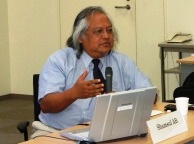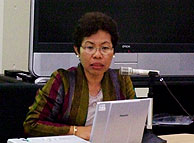
|
■報告要旨 国際ワークショップ [第四回 国際ワークショップ 2010年7月] From Conflict to Cohesion:? The paradigmatic challenge in analyzing plural societies in Southeast Asia, Malaysia as a case study Shamsul AB(Universiti Kebangsaan Malaysia)
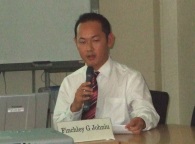
Finchley Godfrey Johniu Institute for Development Studies (Sabah) The Homecoming Ceremony of the Bambarayon The Magavau Ceremony The Merry Making Feast The Unduk Ngadau Kaamatan 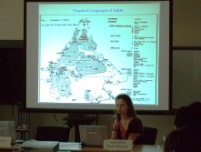
Cultural Diversity and Ethnographic Mapping in Sabah, Malaysia Jacqueline Pugh-Kitingan Universiti Malaysia Sabah
[第三回 国際ワークショップ 2010年1月]
Movements of Sacred Topographies:Mosques as Sites of Violence/Nonviolence in Southern Thailand Chaiwat Satha-Anand, Ph.D. (タイ タマサート大学)
Muslim Refugees in Malaysia: An Analysis of Azizah Kassim (マレーシア国民大学) Since the early seventies, political instability in a few countries in the ASEAN region has forced many of their citizens to leave and many of the emigrants have found their way into Malaysia as asylum seekers and refugees.? The infiltration of refugees into the country in the post-independence era began with the entry into Sabah of displaced Filipinos from the Mindanao region in southern Philippines. This was followed by the inflow of Vietnamese and Cambodians refugees into the Peninsula in the mid seventies. All the Vietnamese refugees have departed either for resettlement in third countries or due to repatriation. The Cambodians whose number was small are now fully integrated into the Malaysian society in the Peninsula while the Filipinos have been given temporary stay in Sabah pending their return to their homeland.? However, as political instability in some areas in the region persisted, the inflow of asylum seekers and refugees into Malaysia continued until today albeit in relatively small numbers. Official statistics from the United Nations High Commissioner for Refugees (UNHCR) Kuala Lumpur reveal that as of October 2009, there were about 63,574 asylum seekers, refugees and people of concern in Malaysia. In addition there are also thousands unregistered ones whose number cannot be ascertained. As Malaysia is not a signatory to the Geneva Convention on Refugees 1951 or the New York Protocol 1967, Malaysia has no legal obligation to accommodate them. Their presence in the country is in violation of immigration rules and regulations. Technically, they are “illegal immigrants” who can be charged, penalized and sent offshore. However, based on humanitarian grounds the Malaysian government has, since the early seventies, allowed asylum seekers and refugees a temporary stay subject to their registration with the UNHCR and until a durable solution is found for them. The permission to stay puts the asylum seekers and refugees in an anomalous legal position as it is not accompanied by the conferment of basic rights to them by the Malaysian authorities.? Out of the total number of refugees in the country, around 91.2 percent are from This paper begins by giving a demographic account of the Rohingyas in Malaysia, their geographical distribution and their status as accorded to them by UNHCR Kuala Lumpur and the Malaysian government. It will then examine the challenges faced by the Rohingyas given their anomalous position and the generally unfriendly socio-political environment in which they live. Without basic rights they are not free to work legally and have no access to social services and public amenities. Their personal safety is also often compromised. How do they cope with and overcome these limitations? What are the general impacts of these limitations on the Rohingya population as a whole? Many Rohingyas have left Myanmar, particularly after the revocation of their citizenship by the Myanmar regime in the early eighties and sought refuge in Muslim countries such as Bangladesh, the Middle East and Malaysia. As Muslims, are the Rohingya refugees getting attention and assistance from local Muslim organizations and individuals in Malaysia? How does being Muslims affect their relationship with international agencies and the Malaysian authorities?? These are some of the questions to which this paper addresses itself. 第一回 国際シンポジウム 2008年12月]
Preparatory Committee for the Implementation of Islamic Sharia (Komite Persiapan Pelaksanaan Syariat Islam / KPPSI) was formed after a series of meetings and conferences starting in 2000. Initially, in August 2000, the first Mujahidin congress was held in Yogyakarta. In October 2000, a three-day Islamic Congress was held in Makassar. The congress was convened to discuss special autonomy for the implementation of Islamic Sharia in South Sulawesi. Diverse groups attended this congress, including student activists, quasi paramilitary groups from all over South Sulawesi, and romantics from the Kahar Muzakkar era, along with active participants from the Yogyakarta congress, like Habib Husain Al-Habsyi and Abubakar Baasyir Abdul Aziz Qahhar Mudzakkar , son of Darul Islam Leader, Abdul Qahhar Mudzakkar), chief of The Preparatory Committee for the Implementation of Sharia argues that the special autonomy granted to Aceh, including the implementation of Sharia, has paved the way for other Indonesian provinces to demand the same status. Azwar Hasan, the general secretary of KPPSI, stated, "We strive for Sharia implementation constitutionally and in reference to the unitary state of the Republic of Indonesia (NKRI) With the purpose of strengthening the spirit of the pro-Sharia groups, the second Islamic Congress was conducted in Makassar in December 2001. The organizing committee of this congress claimed even wider support both for their congress and hence for the struggle. The governor of South Sulawesi, chair of the house of peoples representatives of South Sulawesi (DPRD-I), and mayor of Makassar Municipality were all listed as members of the Advisory Committee for the second congress, as were Muhammad Jusuf Kalla (one of the most respected figures among the South Sulawesi people, a coordinating minister for social welfare during President Megawati’s administration and an elected Vice President in the 2004 election. However, it is unclear to what extent these notables shared or support KPPSI’s ideology or political agendas. Although numerous groups of the South Sulawesi Muslims can be considered in moderate stand with respect to the implementation of strict Sharia in their region, KPPSI was insisted in announcing a pre-prepared draft of a law which would grant special status to South Sulawesi and allow the local government to impose comprehensive Sharia. From the religious point of view, to a certain degree the South Sulawesi Muslim people tend to retain fanatic, rigid and orthodox Islamic beliefs and practices. Historically, it can be said that attempts to implement Sharia in South Sulawesi has a deep-rooted history since the penetration of Islam in the region in the early seventeenth century. When the Darul Islam rebellion led by Abdul Qahhar Mudzakkar was in power in this region in the 1950s, strict Islamic rules had already been applied in some parts. The impact of this movement is still felt and observable within population and Abdul Qahhar Mudzakkar has, to some extent, become a legendary figure and patriot among the older people in South Sulawesi, even after more than fifty years since he died. KPPSI is probably the best example for this influence. In many occasions, KPPSI activists cannot conceal their respect and admiration when it comes to the history of this movement. Of particular importance to note, KPPSI considers that the pioneering attempt made by the Darul Islam to implement some elements of Sharia in South Sulawesi in 1950s is one of the undeniable historical and cultural foundations for its movement today. For many of its members, KPSI was a way of continuing the Darul Islam struggle through constitutional means.
The Malaysian population is multi-ethnic and multi-religious comprising a large Muslim population in addition to Christians, Buddhists, Hindus and others. Except for the dominant Malay population in the Peninsula who by constitutional definition are Muslims, religious and ethnic divide among the other ethnic groups (Bumiputra of Sabah and Sarawak; Chinese, Indians and others) do not overlap. Since the early part of the twentieth century, conversion to Islam by non-Muslims as well as Muslim-non-Muslim inter-marriages is not unusual, involving members of the Malay Royal households and commoners alike. There are many reasons why non-Muslims embrace Islam, but the most common, according to an official source, is to marry a Muslim. Until the eighties, such a marital union especially between non-Muslims and Malays in the Peninsula became an important means of assimilation into the Malay society such that the term “masuk Islam” (conversion to Islam) became synonymous with “masuk Melayu” (becoming a Malay). Two sets of family laws have been put in place, one for the Muslims and the other for non-Muslims. However, the division of areas of jurisdiction between the Muslim Syariah courts and the civil courts was unclear until 1988, when the constitution was amended with the introduction of Article 121 (A), which prohibits the civil courts from intervening in the jurisdiction of the Syariah courts or its decision. This amendment, together with the bureaucratisation and revamping of Islamic administration and institutions under the Malaysian Islamisation project since the early eighties led to various complications in conversion to (and out) of Islam as well as inter-faith marriages involving Muslims causing much controversies between some Muslim and non-Muslim groups in the country, thus bringing these issues into mainstream Malaysian political agenda. In this paper the writer examines the processes of conversions to Islam and Muslims-non-Muslim inter-marriages in Malaysia before and after 1990, to understand the problematic of such processes and its implications on ethnic relations in Malaysia. This paper, which is exploratory in nature, is based on both secondary and primary data.
My paper poses why Mindanao at once convulsed under a double-sided movement for Moro self-determination. As matters had come to a head with the aborted signing of the Memorandum of Agreement on ancestral domain scheduled on August 5, 2008 in Kuala Lumpur, most agreed that the peace talks was done with. As a result, belief grew within the Moro revolutionary fronts in which the political and military segments wage for control ? of what has become known as ‘the peace process.’ The Bangsamoro people’s collective demand was in the compact rights emanating from the regime of Home Rule framed around the Tripoli Agreement on Peace of 2001. Government has had to contend with its own republican ideology that harps on the constitutional issue, however. Is the future political status of the Bangsamoro people negotiable? Absolutely no power can foreclose and agree to negotiate what it considers as a condition of its autonomous existence. I argue that a balance between the right to self-determination and full autonomous existence is reflected in the working drafts and the consensus points of the Government-Moro peace negotiations. On the Moro side, its peace premise is that the progressive resolution of the conflict between the Government and Moros demands a closure to the ambiguity of the associative ties that characterize the totality of relationships between the Bangsamoro people and the rest of the Philippine body politic. On the Government side, its negotiating position telescopes a work in progress or something entirely “a new formula”; it may work a change in the relatively autonomous existence of the country and possibly the nationalist ideology to accommodate asymmetric structure of pluralism in democratic governance. The General Framework for the resumption of the Government-MILF Peace Talks recognizes public reason but requires now guarantee or protocol. Conceptual principles are helpful in understanding restorative justice to deal with the Moro collective rights and their political status of deprivation of foundational shared or ‘earned’ sovereign authority. As the twentieth century closed, fate intervened when the United States tangled with Spain over the Philippine Islands and annexed the Moro population without assurance that a majority of our people desired it. The italicized “status” begs the question: Was the American annexation of Moro homeland to the Philippine republic legal and moral? This is too big a matter to discuss at this point in any detail. Yet it implies extending our conception of political justice from the domestic case of plebiscitary consent. I only mention in passing that the turn-of-twentieth-century American interventionist foreign policy in the Pacific region applied ‘regime change’ to the Philippine Islands. Some say there is no need to conceive toleration for nonliberal peoples. Pressing ‘dismemberment’ is not in our agenda of current peace talks; but we have embraced the “undigested” phrase “self-determination”. Wilsonian aggregation of identity?a race or a culture, a territorial area or a community?into a singular unit congruent with national boarders has remained incomplete. At the dawn of the twenty-first century, ethnic-sorting out has not quite produced a stable territorial configuration but an ‘ungovernable’ region in the southern Philippines. What precisely is the position of stalemated forces at the time of the truce between the Government and Moros? How can there be a policy of appeasement when there is no shortage of broad revolutionary sympathy? There being no sign of imminent military victory, so the logic of stalemate points to a compromise. To apply the new paradigm of the terms of negotiation and diplomatic context in Islamic discourse, we need some working definition. First, in Islamic political theory, the ‘land of unbelief’ is subdivided into the land of harb (war) and the land of sulh (truce). But a compromise can exist in that land under truce: As such Muslims do not wage war or instigate violence or resort to armed means, where a compact is concluded by which a legal regime can develop into a dar-ul-mua’hada ? a territory under compact. Second, in the Islamist diplomatic instrument the Moro negotiating panel proffered a regime of transition covenant to negotiate a political settlement for dar-ul-sulh ? a territory under truce. Such in-built organizing devise intersects where there is sometimes a need for provisions by which a legal regime created by the agreement can develop into full dar-ul-aman. This is consistent with how things work in diplomatic practice. Third, in the Memorandum of agreement on ancestral land, the agreed text states: The entrenchment of compact rights “emanating from the regime of ‘territory under compact’ and ‘territory under peace agreement’ partake (s) the nature of a treaty device.” Writing this part of the Memorandum of Agreement on the Ancestral Domain is meant to correct the historical injustices of the status quo for the purpose of democratic peace. Unfortunately, the Philippine Supreme Court declared the MOA-AD unconstitutional. But beyond the existing constitutional structure based on the organizing principles of Philippine unitary system, much more will have to be asked. Whatever be the banner: freedom, autonomy, or national liberation there is need of a complete calling in question about the justness of the original position. The de facto negotiated political settlement can only be acceptable until political justice is done. To resolve the tension underlying legitimate grievances, the MILF negotiating panel reworked the idea of a social contract as a negotiated political settlement of the Bangsamoro problem in Mindanao. The inclusion of the above conceptual framework as a Term of Reference provides a context within which the “associative ties and tiers” may be established for just peace. Thinking of the “territory under peace agreement,” in a way of re-territorialization, is to entrench the Bangsamoro Juridical Entity (BJE) as a sub-state embracing a land base and internal territorial waters. The issue seems perfect for the contemporary Islamic movement that generated the radical thinking of the 1960s on to the mid-1970s. Around this time the jihadist path was veering into the mood of separatist agitation propaganda overlaid with political commitment between unbelief and Islam. In conclusion, my paper illustrates the context in which the facilitator, negotiators and interlocutors are exercised via thinking outside the box. The fact of reasonable pluralism is parallel to the diversity among reasonable peoples. Originally, the Bangsamoro homeland and historic territory embraced the Mindanao-Sulu-Palawan geographic region. Historical ancestry of the Muslim dominated provinces has been a stony ground for “earned sovereignty” in contemporary political governance and international relations. For brevity, the delimitations are contained in agreed Categories (A, B, C) in agreed text. Apart from demographic ploy used to wiggle plebiscitary results, in past referendums legislative gerrymandering of the conflict-affected areas (CAA) made possible to alter the Moro mandate to demand for Home Rule. Thus the degree of human security has become vital to the geographic areas now designated as Special Intervention Areas with a re-characterization: from sovereignty as control to sovereignty as shared responsibility to protect.
Struggles to defend their freedom, homeland and way of life as well as the quest for peace are persistent themes in the history of the Sulu Moros. Interspersed with peace treaties and resumption of hostilities, the embattled existence of the Sulus has been going on for more than four centuries. The state of war for centuries was, and still is, the source of the underdevelopment of Sulu society as well as the alienation and antagonism between the Sulus and other segments of what is now the Philippine national community. In an historico-political sense, the term Sulus or Sulu Moros referred to the different groups of people who came under the rule of the Sultanate of Sulu. They were the Tausugs, the Samas (Samals), the Yakans, the Jama Mapun, the natives of Palawan, the Badjaus and later, to include the people of the north Borneo, now called Sabah. Today, however, the term Sulus is used in a geographical reference to the people residing in the present Province of Sulu in southern Philippines. This includes the Tausugs, the Samas, the Badjaus, and other groups who identify themselves as inhabitants of Sulu. The Tausugs are predominant and they compose the third largest Moro group in the Philippines. Because of their dominant political role during the heyday of the Sultanate of Sulu, there remain today scattered Tausug communities in the former domains of the Sulu Sultanate in Tawi-Tawi, Basilan, the Zamboanga peninsula, Palawan and Sabah. The coming of Islam not only gradually changed the beliefs of the Sulus from polytheism to monotheism, but also led to the unification of their banuas to a bangsa (nation). Since the establishment of the Sultanate of Sulu around 1450, the Sulus referred to themselves as Bangsa Sug (Sulu Nation). At the height of its power, the territorial domains of the Sultanate included the entire Sulu archipelago (i.e. including Tawi-Tawi), Basilan, Palawan, the southern tip of Zamboanga peninsula and North Borneo (now Sabah). The Sultanate of Sulu was a mutli-ethnic state and was the first and only native state that survived the onslaught of Spanish colonialism in what is now the Philippine archipelago. The Sulus’ bloody and mainly successful resistance against Spain for centuries was an effort to defend their freedom, homeland and way of life. The same could be said of their resistance against America, particularly the American policy to incorporate the Sulus into the Philippine body politic. But history has also demonstrated that the Sulus have seldom turned their back at any opportunity to make peace with their enemies. Historically, it was only during the American colonial regime that Sulu society was gradually incorporated into the Philippine body politic. This was accomplished either by force or persuasion by the American colonizers and their native allies. By then, the term Moro problem emerged. To the Americans and their native allies then, the problem was entirely the Sulus and their “backward” society while there was nothing wrong with their encroachment into the Sulu archipelago. There is no doubt, therefore, that a glance at Sulu’s history would reveal that armed resistance seems to be a destiny that the Sulus have learned to accept. Indeed, it was a destiny manifested by one of the longest series of wars ever fought not only in the Philippines but in Southeast Asia. What makes this fact significant is that literature written about the Sulu Moros hardly hints at a history of peace. Indeed, since the last quarter of the 16th century up to the present, there is no generation in the Sulu archipelago that has not fought or witnessed war in their homeland. Other segments of Philippine society today are still tempted to say that the Sulus have never been peaceful people. This attitude tends to perpetuate the image of the Sulus and other Moros, including Islam in the Philippines, as one that espouses violence and exclusivism. On the contrary, it was, and still is, the Sulus’ desire to live in peace in their homeland that led their life to be described by others as one of violence. One of the problems we face today, and the same is true to generations before us, is how Moro resistance against Spain and America can be accommodated within the framework of a truly national struggle for freedom. The history of the struggle for freedom of the Filipino people (including the Moros) cannot just revolve around the events of the 1890’s particularly the short lived revolution of 1896. Such history should include the struggles of those who preserved their freedom and those who endeavored to regain their freedom since 1896. It is now over a century since the declaration of Philippine independence on June 12, 1898 and more than sixty years since the achievement of formal independence from the United States on July 4, 1946. But Philippine society remains insufficiently cohesive. Philippine nationalism has not fully gained acceptance in Moro areas.
This paper is the result of my research comprising 9 other research projects. It is an attempt to raise questions whether the Thai state has always faced southern violence, especially the new escalation, without any comprehensive policy, grounded in ignorance and without any willingness to learn about the Malay Muslims, their ways of life and history? Or is this because those who have to deal with the issue(s) of southern violence, especially on the side of the Thai state, have imagined this land and its people as “a special space” and then reproduced such imagination into policies and practices that “ do not go far enough, nor see things with clarity”. Based on knowledge gained from field and documentary research, the study shows that the area plagued with violence at present is a “special space”. As a result, there have always existed specific security policies designed for this particular area, vast amount of special “knowledge” on this area and because it suffers from “security problems”, both agencies and personnel, civilian and military alike, must go through special recruitment process, then they will have to go through orientations guided by “manuals” specifically prepared to help Thai civil servants perform their duties in just such a context. The American empire and the Muslim world’s gazes have also been on southern Thailand because for the former this space has become a part of the Southeast Asian anti-terrorism war front, while for the latter ? it is another case of Muslim minority suffered at the hands of an unjust non-Muslim government. Victims of violence, both Buddhists and Muslims, ordinary people and civil servants, lose their lives, families, livelihood so much so that those who could decided to leave this land. I would argue that no matter how a space or territory is imagined, or by whomsoever, problems of violence could arise. In the final analysis, though the land, the space, and territory are geographical concepts, they are significantly juridico-political geography, permeated with power. For those who are in control of the land, it seems normal and/or logical to exercise their power since it has long been in their possession, so long it has been hard to find traces of past freedom.
The southernmost provinces of Thailand have been a site conflict and resistance since 1902, when the area was first annexed by the Kingdom of Siam. The resurgence of tension that began on January 4, 2004 has led to a plethora of problems and violence. With each passing day, a greater number of people in the South are affected by violence, either directly or second hand, through the experiences of their relatives, friends and neighbours. Insecurity in Southern Thailand has led to an industry of peace. The central government has allocated a huge sum of the national budget “for,” or “to develop” people in the area. Well-intentioned and concerned parties, from both inside and outside of the country, have staged a number of interventions aimed at restoring justice and peace in the area. Even as these outside interventions are generally viewed as essential to development, healing and the peacemaking process, the activities and actions involved are rarely evaluated and monitored in terms of their effectiveness or their role in the continuing conflict. I have received a number of complaints from both Buddhists and Muslims in the region concerning the interventions. For example, many local Buddhists feel they have been left out of the process, particularly in terms of assistance from human rights advocates. Many small-scale fisher-folk and forest dwellers who have been fighting for rights to fish and to live in the forest have asked me why human rights activists are not interested in advocating for their collective rights, but only in cases of individual rights involving torture or disappearance. Others wonder why they have become the target of study for academics, researchers and journalists, oftentimes without their participation and consent, and without explanation as to why they are being interviewed or what is eventually found in these studies. This paper aims to explore briefly the role of peace actors in the region, be they human rights activists, journalists, academics and researchers, or members of a peace-keeping force. What are they doing? How do they operate? What factions exist among them? How might their interventions contribute to an equitable and lasting peace? The central purpose of this paper is to reflect the views of locals on these interveners, and to consider further what role and priorities such outside actors should have in the complex situation. Additionally, the paper aims to discuss the struggle of local community-based organisations, whose members are trying to live as devout Muslims amidst the mayhem, while also attempting to manage the dilemma of “otherness” in their own society. I will examine how these locals use their knowledge base and collective rights to work for a hope-filled, lasting peace. There may not be best practices or experiences from elsewhere that can be applied to solve the problems in the far South given the unique issues of religion, ethnicity, language and history that underlie the conflict. The paper argues that interventions in the region should not place too much emphasis on the way to end violence without first establishing a clear means to create a just and sustainable society. In the long run, peace will only be sustained if the efforts of outside interveners are reinforced by the participation and integration of locals in the justice, peace, healing and development processes. Genuine empowerment of the local people in the Southern region is thus the key to a lasting peace.
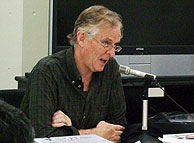
Islam in Southeast Asia: before and after the arrival of the "public sphere". Presentation Anthony Milner (東京外国語大学AA研) When Islam was first adopted in the Archipelago it is unlikely that the transition was traumatic. Key social and religious features of the contemporary Muslim world appear to have been complementary to the structure and dynamics of pre-Islamic local societies (at least as we understand them on the basis of the available evidence). By the eighteenth century the balance of ideas in the international Islamic community had shifted - and certain increasingly prominent doctrines confronted the Archipelago sultanates with a trenchant critique and a program of radical reform. The colonial period brought opportunities for Islamic critics, and in some ways undermined the defenders of the status quo. It also helped to create new proponents of reform - including nationalists who possessed an agenda for the future that was at least partly secular in character. In the colonial era another development was the constituting of the 'public sphere'. This meant that religious debate would now take place in a new context.
[第一回 国際ワークショップ および 第一回公開セミナー 2007年2月] 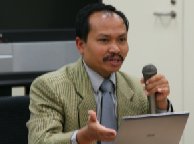
RADICLA ISLAM? THE FUTURE OF ISLAM IN INDONESIA JAMHARI MAKRUF In the aftermath of the Southeast Asian political and economic crisis in the late 1990s, the rise of radical Muslim groups in Indonesia spawned intense debate on the presence of a new threat of political Islam. Scholars, journalists and policy makers alike were quick to classify these new Islamist movements as a part of a global network of radical Islam spanning from the Middle East, to North Africa, South Asia, and to Southeast Asia. However, in recent times this prognostication and characterization of Muslims in the country had to some degree diminished, with attention has been paid to different cultural and ideological understandings of Islam between the Middle East and Southeast Asia. The issues of radical Islamist uprisings were relegated to the margins of debate largely because of the impressive achievement of political Islam in Indonesia to participate in the nation's consolidation to democracy, maintenance of religious pluralism, and coping with modernity. While the radical upsurge of Indonesia Islam should not detract from the significant signal of the emergence of global Islamist networks, it did illustrate quite profoundly that beneath renewed interest in political Islam in academia--an interest that has been sparked in part by a debate of the compatibility between Islam and democracy-lie a tendency of scholars to treat Islamist politics as an uniform phenomenon over time. Political Islam can be situated as a group of peoples and political communities who hold a set of ideologies derived from the doctrine that Islam is not only a religion, but also a political system that governs the legal, economic and social imperatives of the state. Nevertheless, traversing through the history of political Islam in Indonesia, it is apparent that there are variations as to how various Muslim organizations developed their programs, formulated their organizational and ideological forms, managed their strengths and translated their political action vis-?-vis the political regimes, and carried out more or less successfully in coping with the problems of religious pluralism. One of the most significant achievements of Islamist organizations (both in the forms of political party organizations and civic associations) is their willingness to work within the existing political system for the advancement of its goals. Islamic organizations throughout the past 60 years have intermittently played a political role under both democratic and authoritarian circumstances. The two largest organizations that emerged in the early 20th century, Muhammadiyah (the Spirit of Muhammad), a modernist-reformist organization, and Nahdlatul Ulama (The Awakening of Religious Scholars), a traditional ulama-affiliated organization, support the existence of nation state and direct their program towards serving society at large beyond Muslim communities. Indonesian Islamist political parties, although in its earliest phases have attempted to establish an Islamic state, compete fairly in subsequent democratic elections. The ability of some Muslim political organizations to enter into this formal political participation stands out as major milestones of the development of Indonesian Islam. Three main features bear testimony to this achievement: (1) the continued support of Muslim communities in Indonesia for the nation-state and its Constitution; (2) the preference of Indonesian Muslims to advocate debates and dialogue in pursuing their political goals, instead of hostility and violence; and (3) the strong will of Indonesian Muslim political organizations to move from religiously-based politics and actions into broader framework of political struggles such as democracy, poverty alleviation, gender equality and human rights. A second feature of theachievement is perhaps the Muslims' prominent role in promoting multicultural understandings among people with different beliefs, ideologies, and cultural identities. Observers often portrayed the current Islamic activism in the Muslim world as a phenomenon that encourages violence and terrorism and poses a risk to political freedoms and civilization. James Walsh, an expert on Middle East politics, for example, indicates that Islamist political movements raise concerns for lives and freedoms. They suffer from terrorism, intolerance and revolutionary transformation. Islamic organizations in Indonesia, however, have intensified their involvement in struggling for the coexistence among religious communities and other cultural groups. Important to these particular political outcomes should be addressed to the role of modern education in Indonesia, especially religious education in public schools. Under the New Order, religious education is understood to ensure that students will be able to maintain their faith and religious practices according to their own religious tradition. As a result, religious education in Indonesian public schools has generally led to the division of classrooms according to the students' creed. In other words, students are segregated according to their religious beliefs during religious instruction in public schools. This is to ensure that each of students receives proper religious instruction in school, that is religious instruction of their own religion, not that of others. Interestingly, the trend indicates that Indonesian schools tend to be more religious in an increasingly secular society.
|
